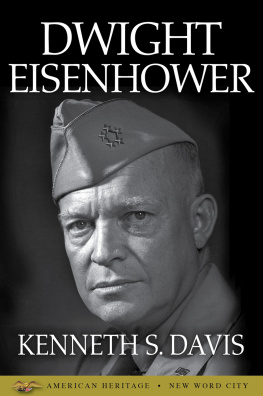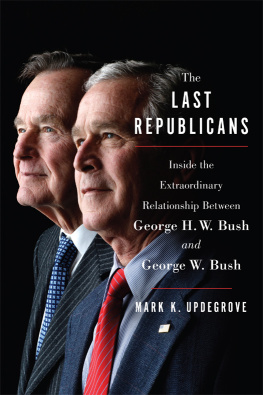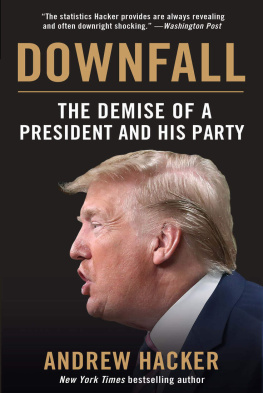Copyright 2010 by Princeton University Press
Requests for permission to reproduce material from this work should be sent to Permissions, Princeton University Press
Published by Princeton University Press, 41 William Street,
Princeton, New Jersey 08540
In the United Kingdom: Princeton University Press, 6 Oxford Street, Woodstock, Oxfordshire OX20 1TW
All Rights Reserved
Library of Congress Cataloging-in-Publication Data
Galvin, Daniel.
Presidential party building : Dwight D. Eisenhower to George W. Bush / Daniel J. Galvin.
p. cm. (Princeton studies in american politics)
Includes bibliographical references and index.
ISBN 978-0-691-13692-9 (hardcover : alk. paper) ISBN 978-0-691-13693-6 (pbk. : alk. paper) 1. Political partiesUnited StatesHistory20th century. 2. Political leadership United StatesHistory20th century. 3. PresidentsUnited StatesHistory20th century. 4. United StatesPolitics and government1945-1989. 5. Eisenhower, Dwight D. (Dwight David), 18901969 6. Bush, George W. (George Walker), 1946 I. Title.
JK2261.G35 2010
324.27309'045dc22 | 2009020971 |
British Library Cataloging-in-Publication Data is available
This book has been composed in Minion and Myriad
Printed on acid-free paper.
press.princeton.edu
Printed in the United States of America
10 9 8 7 6 5 4 3 2 1
Preface |
Political parties have long been viewed as vital to democracy in America. But they have also been a perennial source of disappointment for small-d democrats: rarely have they proven capable of performing the many functions that are ascribed to them. In the latter half of the twentieth century, as the partisan attachments of voters began to loosen and party organizations seemed to fade in importance relative to interest groups, the mass media, and candidate-centered campaigns, frustrated scholars and concerned citizens began to search for the causes of party failure and decline. There were many culprits to be found: some were deeply rooted, like the peculiar design of the constitutional system. Others were more recent developments, such as technological change and the rise of the national administrative state. But a good deal of the blame was also placed on our modern American presidentsthose notoriously ambitious, self-aggrandizing figureswho, scholars said, had abdicated their roles as party leaders.
Recent presidents, scholars observed, had willfully exploited their parties in pursuit of their self-interests. Rather than support their parties and promote collective responsibility, they took what they needed and gave little, if anything, back. Whats more, modern presidential practicessuch as speaking directly to the people, relying on independent campaign committees, and building a partylike apparatus within the White Houseonly served to push the parties further to the sidelines of national politics and undercut their traditional functions. Modern presidents were not party leaders, scholars argued, they were party predators.
Despite the fact that this observation lacked clear empirical referents, the notion that the president-party relationship was deeply problematic soon became conventional wisdom. Reinforced over the years by the repetition of familiar anecdotes and theoretical claims, it repeatedly escaped critical scrutiny.
In this book, I seek to reopen this question of long-standing interest. How, exactly, do presidents interact with their parties? Why do they do what they do, and with what effect? In my investigation of every presidential administration since Dwight D. Eisenhower, I find that the president-party relationship has not, in fact, been all of a piece. Contrary to conventional wisdom, modern presidents have not acted in a uniform manner toward their parties. Democratic and Republican presidents approached their parties quite differently, for different reasons, and with very different consequences.
Republican presidents, I find, worked persistently to build their party into a stronger and more durable political organization. Motivated by their partys minority status to build a new Republican majority that would reflect and perpetuate their political purposes after they left office, they made forward-looking investments in their partys organizational capacities. More often than not, they failed to build the new majority they envisioned, and their personal brand of politics faded into history. But through their party-building efforts, they made incremental contributions to their partys cumulative organizational development and encouraged their successors to do the same.
The notion of the president as party predator, I argue, is best viewed as an exclusively Democratic phenomenon. Since John F. Kennedys presidencyuntil Bill Clintons second termDemocratic presidents neglected their party, exploited it for short-term gain, or undercut its organizational capacities. Though they were often presented with the opportunity to make constructive investments in their party organization, they repeatedly refused. With deep and durable Democratic majorities in the electorate and at the congressional, state, and local levels, they had little reason to believe that their exploitation of the party apparatus in the short run would make much of a difference in the long run. They were not out to build a new majority, but to make use of the one they had. But by keeping their partys resources scarce and its operational capacities inchoate, they made cumulative organizational development in their party more difficult.
When the Democrats lost their long-standing majorities during the 1990s, their approach to organizational matters began to change. Bill Clinton and his team made a number of targeted investments in the party organization, and subsequent party leaders followed suit. But as we have seen in recent years, though new electoral uncertainties created new incentives for party building, translating those incentives into change at the organizational level happened only gradually, in a piecemeal fashion. Incremental investments led to cumulative gains over time as party leaders from Terry McAuliffe to Howard Dean to Barack Obama inherited an increasingly robust party apparatus upon which they could continue to build. As the following chapters demonstrate, this is precisely what characterized the process of organizational change in the Republican Party over the last half-century as well.
By missing out on these patterns of presidential behavior over the last fifty-plus years, not only have our normative concerns been largely misguided, but we have turned a blind eye to an important dynamic of modern American political development that has clearly shaped the politics of our day. Whether by building his party or by standing in its way, each modern president helped to push his party along a unique organizational trajectory. Indeed, the contemporary political landscape can now be characterized by the different speed and rhythm of each partys development; future political contests will undoubtedly be animated by the different challenges each party now faces. For all these reasons and more, the following pages seek to bring the president-party relationship into sharper relief.









